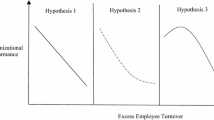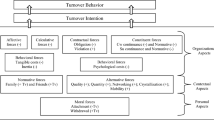Abstract
Within the field of behavior analysis, turnover can impact an organization adversely due to the loss of expertise and the required replacement expenses. Turnover in behavior analysis remains poorly understood, and few investigations have studied why employees separate and how to mitigate unwanted turnover. The purpose of this discussion article is to provide an account of turnover, as well as to make recommendations to behavior-analytic service providers regarding how to perform analyses and intervene to decrease employee turnover.


Similar content being viewed by others
Notes
The term rate, used here, originates from the human resources literature describing turnover over time and is expressed as a percentage. As used in this context, the term rate does not necessarily construe a behavior-analytic definition.
References
Aarons, G. A., Sommerfeld, D. H., Hecht, D. B., Silovsky, J. F., & Chaffin, M. J. (2009). The impact of evidence-based practice implementation and fidelity monitoring on staff turnover: Evidence for a protective effect. Journal of Consulting and Clinical Psychology, 77, 270–280. https://doi.org/10.1037/a0013223.
Allen, D. G., Weeks, K. P., & Moffitt, K. R. (2005). Turnover intentions and voluntary turnover: The moderating roles of self-monitoring, locus of control, proactive personality, and risk aversion. Journal of Applied Psychology, 90, 980–990. https://doi.org/10.1037/0021-9010.90.5.980.
Daniels, A. C., & Bailey, J. S. (2014). Performance management: Changing behavior that drives organizational effectiveness (5th ed.). Atlanta, GA: Performance Management Publications.
Dougherty, T. W., Bluedorn, A. C., & Keon, T. L. (1985). Precursors of employee turnover: A multiple sample causal analysis. Journal of Organizational Behavior, 6, 259–271. https://doi.org/10.1002/job.4030060404.
Flint, A., & Webster, J. (2013). Exit interviews to reduce turnover amongst healthcare professionals [Review]. Cochrane Systematic Reviews, 28, 1–27. https://doi.org/10.1002/14651858.CD006620.pub3.
Fox, K. C. (2010). Mentor program boosts new nurses’ satisfaction and lowers turnover rate. Journal of Continuing Education in Nursing, 7, 311–316. https://doi.org/10.3928/00220124-20100401-04.
Frederiksen, L. W., & Riley, A. W. (Eds.). (1984). Improving staff effectiveness in human service settings: Organizational behavior management approaches. New York, NY: Routledge.
Gravina, N., Villacorta, J., Albert, K., Clark, R., Curry, S., & Wilder, D. A. (2018). A literature review of organizational behavior management interventions in human service settings from 1990 to 2016. Journal of Organizational Behavior Management, 38, 191–224. https://doi.org/10.1080/01608061.2018.1454872.
Harris, D. H. (2000). The benefits of exit interviews. Information Systems Management, 17, 17–20. https://doi.org/10.1201/1078/43192.17.3.20000601/31236.3.
Hayes, L. J., O’Brien-Pallas, L., Duffield, C., Shamian, J., Buchan, J., Hughes, F., et al. (2006). Nurse turnover: A literature review. International Journal of Nursing Studies, 43, 237–263. https://doi.org/10.1016/j.ijnurstu.2005.02.007.
Heavey, A. L., Holwerda, J. A., & Hausknecht, J. P. (2013). Causes and consequences of collective turnover: A meta-analytic review. Journal of Applied Psychology, 98, 412–453. https://doi.org/10.1037/a0032380.
Hewitt, A., & Larson, S. (2007). The direct support workforce in community supports to individuals with developmental disabilities: Issues, implications, and promising practices. Mental Retardation and Developmental Disabilities, 13, 178–187. https://doi.org/10.1002/mrdd.20151.
Hurt, A. A., Grist, C. L., Malesky Jr., L. A., & McCord, D. M. (2013). Personality traits associated with occupational “burnout” in ABA therapists. Journal of Applied Research in Intellectual Disabilities, 26, 299–308. https://doi.org/10.1111/jar.12043.
Kazemi, E., Shapiro, M., & Kavner, A. (2015). Predictors of intention to turnover in behavior technicians working with individuals with autism spectrum disorder. Research in Autism Spectrum Disorders, 17, 106–115.
Kupperschmidt, B. R. (2002). Unlicensed assistive personnel retention and realistic job previews. Nursing Economics, 20, 279–283.
Larson, S. A., Tolbize, M. S. A., Kim, O., & York, B. (2016). Direct support professional turnover costs in small group homes: A case study. Minneapolis: University of Minnesota, Research and Training Center on Community Living.
Maertz Jr., C. P., Griffeth, R. W., Campbell, N. S., & Allen, D. G. (2007). The effects of perceived organizational support and perceived supervisor support on employee turnover. Journal of Organizational Behavior, 28, 1059–1075. https://doi.org/10.1002/job.472.
Mitchell, M., & Zatzick, C. D. (2015). Skill underutilization and collective turnover in a professional service firm. Journal of Management Development, 7, 787–802.
Mitchell, T. R., Burch, T. C., & Lee, T. W. (2014). The need to consider time, level, and trends: A turnover perspective. Journal of Organizational Behavior, 35, 296–300.
Mottet, L. M. (2006). Nurse mentor magic: Training for nurses. Dubuque, IA: Simon & Kolz.
Newcomb, E. T., Camblin, J. G., Jones, F. D., & Wine, B. (2019). On the implementation of a gamified professional development system for direct care staff. Journal of Organizational Behavior Management. Advance online publication. https://doi.org/10.1080/01608061.2019.1632243.
Pace, V. L., & Kisamore, J. L. (2017). Strategic exit interviewing: Encouraging voice, enhancing alignment and examining process. Journal of Organizational Effectiveness: People and Performance, 4, 59–75. https://doi.org/10.1108/JOEPP-03-2016-0023.
Peltokorpi, V., Allen, D. G., & Froese, F. (2015). Organizational embeddedness, turnover intentions, and voluntary turnover: The moderating effects of employee demographic characteristics and value orientations. Journal of Organizational Behavior, 36, 292–312. https://doi.org/10.1002/job.1981.
Plantiveau, C., Dounavi, K., & Virues-Ortega, J. (2018). High levels of burnout among early-career board-certified behavior analysts with low collegial support in the work environment. European Journal of Behavior Analysis, 19, 195–207. https://doi.org/10.1080/15021149.2018.1438339.
Premack, S. L., & Wanous, J. P. (1985). A meta-analysis of realistic job preview experiments. Journal of Applied Psychology, 70, 706–719. https://doi.org/10.1037/0021-9010.70.4.706.
Rubenstein, A. L., Kammeyer-Mueller, J. D., Wang, M., & Thundiyil, T. G. (2018). “Embedded” at hire? Predicting the voluntary and involuntary turnover of new employees. Journal of Organizational Behavior, 40, 342–359. https://doi.org/10.1002/job.2335.
Society for Human Resource Management. (2015). How to determine turnover rate. Retrieved from https://www.shrm.org/resourcesandtools/tools-and-samples/how-to-guides/pages/determineturnoverrate.aspx
Strolin-Goltzman, J., Lawrence, C., Auerbach, C., Caringi, J., Claiborne, N., Lawson, H., et al. (2009). Design teams: A promising organizational intervention for improving turnover rates in the child welfare workforce. Child Welfare, 88, 149–168.
Strouse, M. C., Carroll-Hernandez, T. A., Sherman, J. A., & Sheldon, J. B. (2004). Turning over turnover: The evaluation of a staff scheduling system in a community-based program for adults with developmental disabilities. Journal of Organizational Behavior Management, 23, 45–63. https://doi.org/10.1300/J075v23n0204.
Sulek, R., Trembath, D., Paynter, J., Keen, D., & Simpson, K. (2017). Inconsistent staffing and its impact on service delivery in ASD early-intervention. Research in Developmental Disabilities, 63, 18–27. https://doi.org/10.1016/j.ridd.2017.02.007.
Weiss, D. J., Davis, R. V., England, G. W., & Lofquist, L. H. (1967). Manual for the Minneapolis satisfaction questionnaire. Minneapolis: University of Minnesota, Industrial Relations Center.
Author information
Authors and Affiliations
Corresponding author
Ethics declarations
Conflict of Interest
Byron Wine has no conflict of interest. Matthew R. Osborne has no conflict of interest. Eli T. Newcomb has no conflict of interest.
Ethical Approval
This article does not contain any studies with human participants or animals performed by any of the authors.
Additional information
Publisher’s Note
Springer Nature remains neutral with regard to jurisdictional claims in published maps and institutional affiliations.
Rights and permissions
About this article
Cite this article
Wine, B., Osborne, M.R. & Newcomb, E.T. On Turnover in Human Services. Behav Analysis Practice 13, 492–501 (2020). https://doi.org/10.1007/s40617-019-00399-6
Published:
Issue Date:
DOI: https://doi.org/10.1007/s40617-019-00399-6




